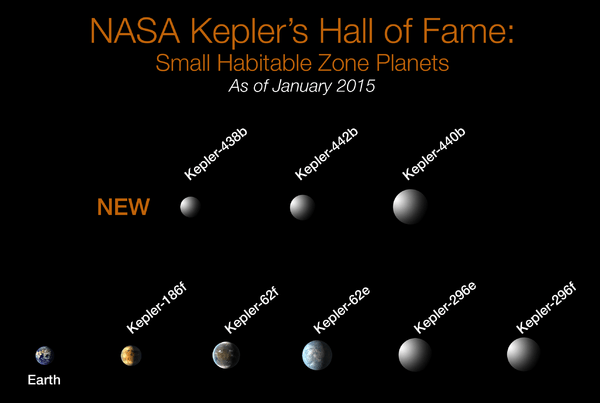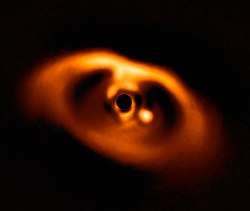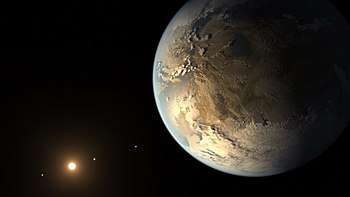Kepler-296e
Kepler-296e (also known by its Kepler Object of Interest designation KOI-1422.05) is a confirmed Earth-sized exoplanet orbiting within the habitable zone of Kepler-296. The planet was discovered by NASA's Kepler spacecraft using the transit method, in which the dimming effect that a planet causes as it crosses in front of its star is measured. NASA announced the discovery of the exoplanet on 26 February 2014.[1]
| Discovery | |
|---|---|
| Discovery site | Kepler Space Observatory |
| Discovery date | 2014 |
| Transit | |
| Orbital characteristics | |
| 0.17400 AU (26,030,000 km) | |
| 34.14234700 d | |
| Inclination | 89.950 |
| Star | Kepler-296 |
| Physical characteristics | |
Mean radius | 1.750 R⊕ |
| Temperature | 267 K (−6 °C; 21 °F) |
Confirmed exoplanet
Kepler-296e is a super-Earth with a radius 1.75 times that of Earth. The planet orbits Kepler-296 once every 34.1 days.
Habitability
The planet was announced as being located within the habitable zone of Kepler-296, a region where liquid water could exist on the surface of the planet. As of 2017, with an ESI of 0.85, it is the fifth-most Earth-like planet after Kepler-438b, TRAPPIST-1 d, and two Gliese-designated planets, GJ 3323 b and GJ 273 b, which were both discovered in 2017.[4]
| Notable Exoplanets – Kepler Space Telescope |
|---|
 (Kepler-62e, Kepler-62f, Kepler-186f, Kepler-296e, Kepler-296f, Kepler-438b, Kepler-440b, Kepler-442b) (Kepler Space Telescope; 6 January 2015).[5] |
References
- Staff (26 February 2014). "715 Newly Verified Planets More Than Triples the Number of Confirmed Kepler Planets". NASA. Retrieved 8 January 2015.
- Lissauer, Jack J.; et al. (25 February 2014). "Validation of Kepler's Multiple Planet Candidates. II: Refined Statistical Framework and Descriptions of Systems of Special Interest". arXiv:1402.6352. Bibcode:2014ApJ...784...44L. doi:10.1088/0004-637X/784/1/44. Cite journal requires
|journal=(help) - Rowe, Jason F. "Validation of Kepler's Multiple Planet Candidates. III: Light Curve Analysis & Announcement of Hundreds of New Multi-planet Systems". The Astrophysical Journal. 784 (1): 45. arXiv:1402.6534. Bibcode:2014ApJ...784...45R. doi:10.1088/0004-637X/784/1/45.
- http://phl.upr.edu/projects/habitable-exoplanets-catalog/data
- Clavin, Whitney; Chou, Felicia; Johnson, Michele (6 January 2015). "NASA's Kepler Marks 1,000th Exoplanet Discovery, Uncovers More Small Worlds in Habitable Zones". NASA. Retrieved 6 January 2015.
External links
| Wikimedia Commons has media related to Kepler Mission. |



